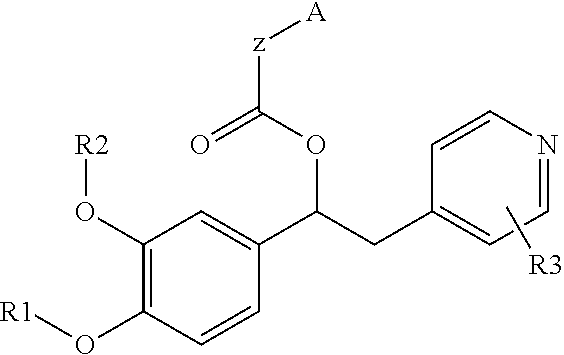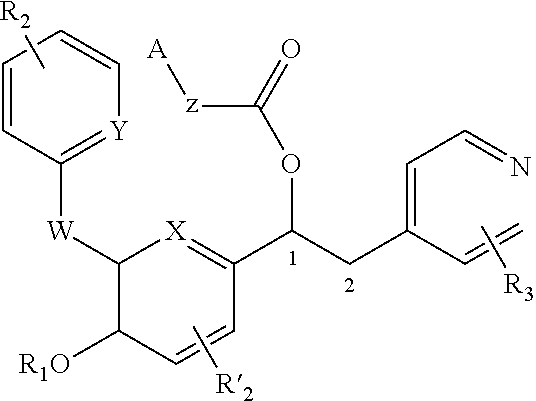Derivatives of 1-phenyl-2-pyridinyl alkyl alcohols as phosphodiesterase inhibitors
a technology of pyridinyl alkyl alcohol and phosphodiesterase, which is applied in the direction of biocide, inhalator, medical atomiser, etc., can solve the problems of limited use of several pde4 inhibitors of the first-generation such as rolipram and piclamilas
- Summary
- Abstract
- Description
- Claims
- Application Information
AI Technical Summary
Benefits of technology
Problems solved by technology
Method used
Image
Examples
example 1
(S)-3,5-Dichloro-4-(2-(3,4-dimethoxyphenyl)-2-hydroxyethyl)pyridine 1-oxide (Compound 5)
[0357]
Step 1: Preparation of 2-(3,5-dichloropyridin-4-yl)-1-(3,4-dimethoxyphenyl)ethanol (1)
[0358]3,5-dichloro-4-methylpyridine (54 g, 331 mmol) was dissolved in dry THF (480 mL) under argon atmosphere and cooled at −78° C. in dry-ice / acetone bath. LHMDS 1N THF solution (331 ml, 331 mmol) was added drop-wise keeping the temperature at −78°. The mixture was stirred at −78° for 1 hour. Thereafter, a solution of 3,4-dimethoxybenzaldehyde (50 g, 301 mmol) in dry THF (120 ml) was added drop-wise keeping the temperature at −78° C. When the addition was completed, the mixture was allowed to warm at RT.
[0359]The reaction was poured into ice and water (1 L) and the mixture was stirred until a copious precipitate formed. The solid was filtered, and dissolved in ethyl acetate (500 ml), dried over Na2SO4 and the solvent evaporated under vacuum. The crude was crystallized in CHCl3 / hexane. The precipitate was ...
example 2
(S)-4-(2-(2-(6-Amino-1-oxoisoindolin-2-yl)acetoxy)-2-(3-(cyclopropylmethoxy)-4-(difluoromethoxy)phenyl)ethyl)-3,5-dichloropyridine 1-oxide (Compound 9) and (S)-3,5-Dichloro-4-(2-(3-(cyclopropylmethoxy)-4-(difluoromethoxy)phenyl)-2-(2-(6-(methylsulfonamido)-1-oxoisoindolin-2-yl)acetoxy)ethyl)pyridine 1-oxide (Compound 10)
[0364]
Step 1: Preparation of 2-(6-(tert-butoxycarbonylamino)-1-oxoisoindolin-2-yl)acetic acid (6)
[0365]2-(6-amino-1-oxoisoindolin-2-yl)acetic acid (200 mg, 0.970 mmol) was dissolved in THF (5 ml), then di-tert-butyl dicarbonate (0.676 ml, 2.91 mmol), sodium bicarbonate (122 mg, 1.455 mmol) and water (5 ml, 278 mmol) were added, and the reaction was stirred at RT overnight. The solvent was removed under vacuum, and the mixture was diluted with HCl 1M and extracted with EtOAc. The organic phase was dried over Na2SO4 and concentrated under vacuum to give 2-(6-(tert-butoxycarbonylamino)-1-oxoisoindolin-2-yl)acetic acid (200 mg, 0.653 mmol, 67 / 0 yield). MS / ESI+ 296.07 [MH...
example 3
(S)-3,5-Dichloro-4-(2-(3-(cyclopropylmethoxy)-4-(difluoromethoxy)-phenyl)-2-(2-(4-nitro-1,3-dioxoisoindolin-2-yl)acetoxy)ethyl)-pyridine 1-oxide (Compound 11) and (S)-4-(2-(2-(4-amino-1,3-dioxoisoindolin-2-yl)acetoxy)-2-(3-(cyclopropyl methoxy)-4-(difluoromethoxy)phenyl)ethyl)-3,5-dichloropyridine 1-oxide (Compound 12)
[0369]
Step 1: Preparation of (S)-3,5-dichloro-4-(2-(3-(cyclopropylmethoxy)-4-(difluoromethoxy)phenyl)-2-(2-(4-nitro-1,3-dioxoisoindolin-2-yl)acetoxy)-ethyl)pyridine 1-oxide (11)
[0370](S)-3,5-dichloro-4-(2-(3-(cyclopropylmethoxy)-4-(difluoromethoxy)phenyl)-2-hydroxyethyl)pyridine 1-oxide (100 mg, 0.238 mmol) was placed in a 50 ml round bottom flask and dissolved in DMF (3 ml); EDC (45.6 mg, 0.238 mmol) was added to it followed by DMAP (29.1 mg, 0.238 mmol) and 2-(4-nitro-1,3-dioxoisoindolin-2-yl)acetic acid (90 mg, 0.357 mmol). The reaction was stirred at RT for 6 hours. The reaction was quenched by adding 30 ml of HCl / H2O (1M) and extracted with EtOAc (30 ml). The orga...
PUM
| Property | Measurement | Unit |
|---|---|---|
| Composition | aaaaa | aaaaa |
Abstract
Description
Claims
Application Information
 Login to View More
Login to View More - R&D
- Intellectual Property
- Life Sciences
- Materials
- Tech Scout
- Unparalleled Data Quality
- Higher Quality Content
- 60% Fewer Hallucinations
Browse by: Latest US Patents, China's latest patents, Technical Efficacy Thesaurus, Application Domain, Technology Topic, Popular Technical Reports.
© 2025 PatSnap. All rights reserved.Legal|Privacy policy|Modern Slavery Act Transparency Statement|Sitemap|About US| Contact US: help@patsnap.com



